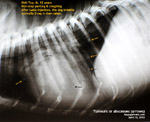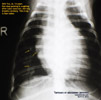A young man in his 30s, accompanied by his senior citizen father, brought in his 12-year-old Shih Tzu that coughs non-stop. He had consulted my associate some 2 weeks ago.
"Can you hear the heart sounds?" I asked Dr Daniel. "Was the old dog suffering from heart disease?"
"Not possible. The lungs were crackling with loud sounds. The mouth has large ulcers, a tumour. The teeth and gums were all infected."
New graduates will quickly do the ABC. Airways, Breathing and Circulation. So, the first thing their vet professor had taught would be to give oxygen therapy. I had seen this being done by new graduates. The dog's tongue was purplish and therefore lacking in oxygen. He could not stop panting.
"He had a seizure when he fell down," the gentleman said to Dr Daniel. Later I told Dr Daniel that the owner had got the process all wrong. There is a stage just before seizure when the dog is unsteady in balance. Seizure comes, he falls down. More fits. Saliva foaming. To the owner, the fall causes the seizures!
What to do in this case? Put on oxygen mask for half an hour?
The professor's lectures of "ABC" are still vivid. The professors may also give the impression or may not, that old vets graduated many years ago are outdated old fogies.
So, must do "ABC" with oxygen therapy first. Gas mask. Switch on the oxygen.
In my experience, a simple IV injection of Lasix will help the dog breathe easy and normal. A bit of dexamethasone perhaps but it is the Lasix that does the trick. So, I advised Lasix. "Give SC and IM," I said as Dr Daniel felt that the dog may be too stressed to be given IV. His tongue was cyanotic and he was about to pass away from lack of oxygen in his blood stream. This is a serious matter. Life and death is always a serious matter.
After 10 minutes, the dog's breathing was back to normal. As I expected. Then we got the dog for the X-ray as the lung fields will be clearer. I don't know whether the professor teaches this procedure or not. In academic lectures, it is probably not possible to teach this way. In real life, the most practical and efficient way in such respiratory distress cases, is the Lasix. One vial. Why Lasix? Because it is a branded product. I could use generic and they should work as well.
X-rays- small nodules in the lungs. "Engorged blood vessels seen end-to-end," the young vet would venture his opinion when I said these would be likely micro-abscesses or tumour metastasized to the lung from the pedunculated one in the umbilical area and from the oral tumour. Each vet has his own opinion as only the MRI scan (too expensive) would confirm. I asked sleepy-eyed Dr Gladys for her opinion as two heads are better than one. She had attended a wake and was really tired. She said: "It could be the small tumours forming. It could be abscesses."
The dog did have a high fever but it could be due to
panting. The blood test results were within the normal limits.
CONCLUSION
Much time must be spent with the owner to educate and explain the
consequences of not taking the heart drugs. Failure to do so lead to
an unhappy owner who hops to another doctor. Usually the last doctor
benefits from the history and treatment. Follow-ups are essential in dogs with heavy panting as
many owners don't comply with medication and don't know what to do
when medication dosage is insufficient.
UPDATE ON APRIL 12, 2012
Follow-up for the next 3 days post-treatment with heart medication.
The thin dog coughs only when excited.
 TOA
PAYOH VETS
TOA
PAYOH VETS


